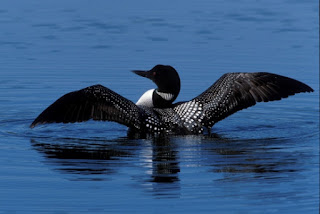The Fading Call of the Loons
November has arrived, and with it come the gray clouds hinting of what's to come. It has never been my favorite time of year, and I often struggle to remain in an upbeat frame of mind. It takes a bit more energy to push through the gloomy days.
Another reason November seems this way is because I know my loons will be departing before long. I have enjoyed listening to their repertoire of calls from spring to fall; imagining all the while what they might be telling one another. Such a beautiful, haunting sound that speaks to my soul. I will miss this very much.
Although I have always loved the loons that return to our lake each year, I had not given much thought to where they went in the winter months. I just assumed they went to warmer climates as other birds do. This article educated me on the wintering of these wonderful friends.
Loons live on freshwater lakes from spring to late fall. At this time, they migrate to the ocean where they live most of the winter as dull grey sea birds, living on crabs and saltwater fish.
Loons on the West coast migrate to the Pacific Ocean, and Midwest loons fly to the Gulf of Mexico. Loons throughout the Northeast migrate to the Atlantic Ocean. Each fall nesting pairs separate and travel individually to different wintering grounds. The immature loons born that season migrate in late November, or later, depending on when the lake freezes over.
Before they migrate, adult males start to change color and lose their bright breeding color. Eventually they are almost totally grey and look more like immature loons. In January they lose all of their wing feathers which makes them vulnerable on the open ocean as they can't fly. It will take 30-45 days for new feathers to grow in.
A few other interesting facts:
- Loons are designed to dive and fish well in water.
- Because of their dense bones and location of their legs, they need to run up to 1/4 mile on the water's surface directly into the wind to get lift for take-off.
- Once they are in the air, they can fly up to 80 miles per hour.
- Both male and female loons return to the same summer and winter locations each year.




Comments
Post a Comment